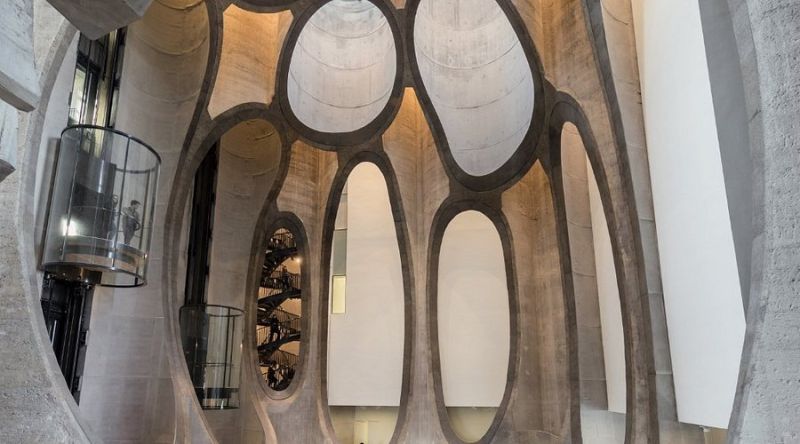
In Cape Town, Zeitz MOCAA represents the radical transformation of a grain silo into a cathedral of contemporary African art. Combining concrete and light, industrial heritage and vibrant creativity, this utopia now tells Africa’s story.
The offshore winds of Cape Town still carry the memory of the port, the muted echoes of colonial trade, and the vertical dream of a continent gazing toward the horizon. At the far end of the Waterfront in the Silo District, a silent concrete giant, abandoned for decades, has come to life as the Zeitz Museum of Contemporary Art Africa. Entering feels like stepping into a sanctuary, the eye drawn to a soaring nave that recalls the industrial past, now a temple celebrating a reinvented Africa.
Zeitz MOCAA was not born from a detached utopia. It is the result of reclamation and reconciliation between an industrial past shaped by extraction, storage, and commercial flows, and a present fully committed to creativity. From 1921 to 1924, Cape Town’s grain silo dominated the bay: 42 concrete tubes, 57 meters high, an austere silhouette overseeing the comings and goings of cargo ships and a rapidly urbanizing South Africa. At the time, it was the tallest building in sub-Saharan Africa, a feat of engineering and an icon of robust, unadorned progress.
But industrial modernity endures neither time nor crisis. The silo fell into slumber, then cracked and slipped into oblivion until 2017, when the architectural genius of British designer Thomas Heatherwick was called in. Rather than demolishing the building, he proposed hollowing it out, carving and sculpting it to reveal its essence. Some cylinders were emptied, the raw concrete polished like gemstones, and light poured in through immense gem-like windows. What was once dark became a cathedral, what was enclosed became an agora.
A 9,500-square-meter museum was born within the veins of the city, 6,000 square meters dedicated to exhibitions, the rest to life: education, workshops, a terrace garden, a café, and, in the ultimate luxury, a hotel perched atop, offering visitors sweeping views of Table Mountain.
Beyond its architectural grandeur, Zeitz MOCAA embodies a deeper purpose. It is not merely a showcase for the globalization of art in search of new markets. Above all, it stands as a declaration that contemporary African art deserves a home on its own continent. Originally championed by German philanthropist Jochen Zeitz, the collection showcases the vibrant diversity of African and diaspora voices through sculptures, installations, photographs, videos and performances. The museum embraces both iconic artists, El Anatsui, William Kentridge, Zanele Muholi, as well as emerging talents striving for recognition.
For centuries, Africa’s story was told by others, displayed in Western showcases, and relegated to the margins of global art history. Here, the roles are reversed: African artists are at home, invited to tell the stories of memory, wounds, and post-colonial violence, as well as the vibrancy of life and the enduring beauty of the everyday.

Zeitz MOCAA: from silo to cathedral of art. © This is Beirut
A walk through the museum reveals the strength of the project. In the atrium, the concrete still bears the marks of its industrial past; in the galleries, the colors, textures, and voices of the works overflow the expected boundaries of “Africanness.” The pathways are varied and open to surprise, and each floor creates a dialogue among different media.
But Zeitz MOCAA is not without its questions. Who really steps through its doors? While entry is free for locals at certain times, it remains costly for many. The Waterfront, an affluent district, naturally attracts tourists and middle-class visitors, but less so the city’s youth, confined to townships and the outskirts. The museum’s governance has also sparked debate: are African artists given true prominence, or does the logic of private patronage and European collecting still dominate?
These questions shape the institution, which must continually adjust its ambitions: expanding access for local audiences, decentralizing workshops, and above all, building partnerships with schools, associations, and NGOs. Yet it may be precisely within this tension between elitism and democratization that Zeitz MOCAA finds its vitality.
What strikes visitors most is the energy of the place. Each year, the museum welcomes nearly 250,000 visitors, a growing number of them young. The Center for Art and Education hosts workshops, residencies, and debates, envisioning art as a gentle weapon against the fractures of the city. On the roof, sculptures converse with the sky; in the corridors, languages, accents, and stories intersect.
In the concrete nave of Zeitz MOCAA, Africa invites the world to follow. Where grains once stacked, the seeds of a living, evolving story now take root.


Comments